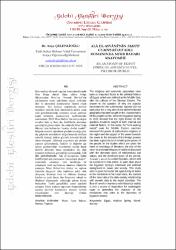| dc.contributor.author | Çelenlioğlu, Asiye | |
| dc.date.accessioned | 2022-08-09T11:48:58Z | |
| dc.date.available | 2022-08-09T11:48:58Z | |
| dc.date.issued | 2019 | en_US |
| dc.identifier.citation | ÇELENLİOĞLU, Asiye. "Alâ El-Asvânî’nin Sahte Cumhuriyet Adlı Romanında Mısır Baharı Anatomisi". Edebî Eleştiri Dergisi, 3.2 (2019): 168-186. | en_US |
| dc.identifier.uri | https://dergipark.org.tr/tr/pub/eeder/issue/49679/611785 | |
| dc.identifier.uri | https://hdl.handle.net/11352/4142 | |
| dc.description.abstract | Batı merkez alınarak yapılan konumlandırmada Orta Doğu olarak ifade edilen bölge ülkelerinden Mısır’ın, Osmanlı Devleti’nin yıkılışından sonra şekillenen siyasî tarihinde dinî ve ekonomik parametreler önemli etken olmuştur. Söz konusu coğrafyada otoriter rejimlere yönelik halk hareketinin neden uzun süre gerçekleşmediği sorusuna cevap, şimdiye kadar halkların karakteristik özelliklerinde aranmışken ‘2011 Mısır Baharı’ bu soruya doğru cevabın hem iç hem dış faktörlerde aranması gerektiğini göstermiştir. Bu anlamda Orta Doğu ülkeleri için kullanılan ‘rantiye devlet modeli’ bölgede otoriter rejimlerin gücünü artırdığı gibi, dış güçlerin menfaatleri doğrultusunda iktidara yönelik desteği halkın gücünü kırmada büyük etken olmuştur. Edebiyat sosyolojisi adı altında yapılan çalışmalarda, ilişkiler ve değerler ağı içinde gözlemlediği insanlardan seçtiği başat tiplerle dönemin başat sorunsalını ele alan romanın toplumsal gerçekliği kavramadaki rolü dile getirilmektedir. Alâ el-Asvânî’nin Sahte Cumhuriyet adlı romanının “sosyolojik eleştiri” zemininde okumaya tabi tutulduğu bu çalışmada, tarih sayfalarına rakamsal ifadelerle yansıyan Mısır Baharı’nın iktidar ve toplum alanında duygusal arka cephesine şahit olan okuyucu, direnişte ölen ve öldüren, direnişe katılan ve uzak duran tüm bireylerin ruhsal ve düşünsel dünyasında yolculuğa çıkma fırsatı bulacaktır. Tarihî gerçeklikle uyum içindeki romanın Mısır toplum yapısının dinamiklerine işaretle devrimi karakterize etmeye hevesli sosyologlara esin kaynağı olması beklenmektedir. | en_US |
| dc.description.abstract | The religious and economic parameters have been an important factor in the political history of Egypt, which was defined as the Middle East, after the collapse of the Ottoman Empire. The answer to the question of why the popular movement for the authoritarian regimes did not take place for a long time in the aforementioned geography has been sought in the characteristics of the peoples so far, while the Egyptian Spring in 2011 showed that the right answer to this question should be sought in both internal and external factors. In this sense, the "rent-seeking model" used for Middle Eastern countries increased the power of authoritarian regimes in the region and the support of the power towards the power in the interests of the foreign powers has been a great factor in breaking the power of the people. In the studies which are under the name of sociology of literature, the role of the novel in understanding social reality is discussed with the dominant types of relationships and values, and the dominant types of the period. Aswany’s novel So-called Republic, which will be examined in this article, is quite clear about the Egyptian Spring's emotional and political background in power and society. This study aims to give the reader the opportunity to listen to the revolution in his local voice, the content of the novel about the state-society relationship will provide data to the social scientists. The flow of novels in harmony with historical reality is also a source of inspiration for sociologists eager to generalize the character of the revolutions that point to the dynamics of Egyptian society. | en_US |
| dc.language.iso | tur | en_US |
| dc.publisher | Abdulhakim Tuğluk | en_US |
| dc.relation.isversionof | 10.31465/eeder.611785 | en_US |
| dc.rights | info:eu-repo/semantics/openAccess | en_US |
| dc.subject | Mısır | en_US |
| dc.subject | Arap Baharı | en_US |
| dc.subject | Roman | en_US |
| dc.subject | Toplum | en_US |
| dc.subject | Egypt | en_US |
| dc.subject | Arabian Spring | en_US |
| dc.subject | Novel | en_US |
| dc.subject | Society | en_US |
| dc.title | Alâ El-Asvânî’nin Sahte Cumhuriyet Adlı Romanında Mısır Baharı Anatomisi | en_US |
| dc.title.alternative | An Anatomy of Egyot Spring in Aswani’s Novel: Pseudo Republic | en_US |
| dc.type | article | en_US |
| dc.relation.journal | Edebî Eleştiri Dergisi | en_US |
| dc.contributor.department | FSM Vakıf Üniversitesi, Eğitim Fakültesi, Yabancı Diller Eğitimi Bölümü | en_US |
| dc.contributor.authorID | https://orcid.org/0000-0003-3197-592X | en_US |
| dc.identifier.volume | 3 | en_US |
| dc.identifier.issue | 2 | en_US |
| dc.identifier.startpage | 168 | en_US |
| dc.identifier.endpage | 186 | en_US |
| dc.relation.publicationcategory | Makale - Uluslararası Hakemli Dergi - Kurum Öğretim Elemanı | en_US |
| dc.contributor.institutionauthor | Çelenlioğlu, Asiye | |



















